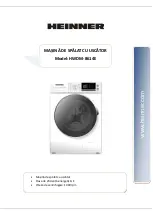
23
Operative Instructions
coverage.
b
HAZARD! Be very careful when inserting
pointed or sharp glassware. Always insert
the glassware starting from the bottom, and
possibly wearing protective gloves.
- When arranging the load, make sure that the spray
arms are not blocked by the load itself.
- After treatment, the transmission instruments
must be cleaned according to the manufacturer's
instructions. After treatment, before reusing the
transmission instruments, check that they are
working properly, e.g. by spraying liquids into the sink.
6.2.3 Summary of the rack loading operations
Depending on the load, special nozzles or adapters may
be required for proper internal cleaning.
Sequence for loading the rack:
1) Fill the rack by arranging the glassware so that all
surfaces are reached during washing.
2) Insert the rack into the chamber.
3) Close the door and start the washing program.
Wide-necked glassware
Wide-necked glassware (such as beakers, Erlenmeyer
flasks and Petri dishes) or cylindrical glassware (such as
test tubes) must be washed and rinsed both internally
and externally. For this purpose, they should be placed
in appropriate inserts and placed in an empty lower or
upper rack.
Narrow-necked glassware
Narrow-necked glassware (such as narrow-necked
Erlenmeyer flasks, flasks and graduated flasks) require
the use of racks with special injection nozzles.
6.2.4 Treatment of glassware
a
WARNING! Insert only glassware suitable
for automatic treatment in glasswasher,
according to the manufacturer’s instructions.
In particular, follow the information
provided by the same manufacturer.
Despite compliance with the manufacturer’s
instructions, in case of damage or alteration
of the glassware, the responsibility will be
borne by the glassware manufacturer.
Before starting the treatment, check that:
- The external surface of the glassware is clean of
material residues (E.g. chloride, hydrochloric acid
etc).
- The air and spray channels must be clean.
- Finally, carry out a test.
Use the recommended liquids (see chapter "Using and
Storing Chemicals").
6.3 Programs
The machine leaves the factory with presetting washing
programs already entered in the settings menu.
For programs details see the Washing Program booklet.
6.3.1 Suggested programs vs configurations
For a good result, it's important to choose the right
program toghether with the righ load/configuration.
To select the programs available, use key P1, P2 or P3
(see Fig. 15) depending on the most suitable program
for the level of dirt of the load.
6.3.2 Program structure
• Drain: It is used to empty the washing chamber.
• Pre-wash: Pre-wash is necessary to eliminate coarse
dirt and foamy substances.
• Wash: Depending on the load, washing normally
takes place at 113°F - 149°F (45°C - 65°C), adding the
appropriate detergent.
• Rinse: The rinsing operation eliminates and
neutralises the chemicals of previous washes.
• Drying: Sufficient drying reduces the risk of corrosion
caused by the residual humidity on the load (not
available for models without drying system).
6.4 Starting the machine
After checking the integrity and full efficiency of the
machine, proceed with start-up:
- Power the machine using the main circuit breaker.
- Open the door (key 5 Fig. 15) to introduce the racks.
6.4.1 Before starting the program
Before starting each program, check:
- That the filters, positioned on the bottom of the
chamber (Fig. 11) are perfectly clean. Clean them, if
necessary.
- The nozzles of the upper and lower spray arms must
be free and clean.
- Products must be arranged correctly.
- The spray arms must be able to rotate freely. The
machine constantly monitors the rotation speed
during the program (optional).
- Liquid containers must be sufficiently filled. Check
for any messages on the display before starting the
program.
Closing the door
- Load the glassware and introduce the racks.
- Close the door and push it until the lock is activated.
The door can be unlocked and opened at any time
before the program starts, by pressing the Door key
Summary of Contents for TIVA8-L
Page 55: ...55 Operative Instructions...
















































